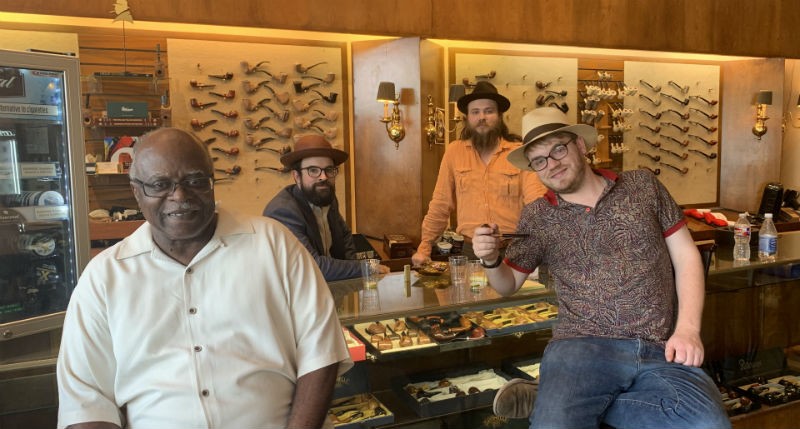As far as trends go, consumers are becoming more interested in individual producers as well as where tobacco is sourced. Cigars with an increased ring size known as jawbreakers were hot for minute, too. Women continue to stake out a small but increasing slice of the market and after all, the elegant pull from a limited edition Sans Pareil lancero vitola was built for all to enjoy.
And are Cubans the best? Well, that’s personal. These days, several enthusiasts would put top tier Dominican Republic and Nicaraguan producers on par with the archetypal Cuban. FYI, they are legal now if purchased outside of the country. Upon entry into the United States, each person is allowed 100 Cuban cigars or up to $800 in purchases every 31 days without paying a duty tax.
From casual tobacco shops like The Briar Shoppe in the Village and Heights Cigar Lounge to chic outlets like Davidoff of Geneva and Embajadores, there are several spots in Houston to score a quality smoke. Though memberships are often available which include varying perks, it isn’t necessary for walk-in clientele aiming to enjoy in the moment. Because the cigar lounge, in essence, is a relaxing environment, many come and light up to get a little work done, wind down from the day, or engage in a bit of conversation.
Here are a few tips and etiquette when visiting a cigar lounge:
1. Quality: Quality is measured by how well a cigar burns, its aroma, and flavor. There are so many different factors in the production of cigars, it’s as intricate as the world of wine — earth, climate, seed, roller, the list goes on. Many hands touch this artisanal, organic product, and price doesn’t always dictate quality. Take advantage of the knowledgeable staff on hand; they're there for a reason.
2. Beginners start with something light: Roberto Eduardo, a Cuban native who has been rolling cigars for 30 years and now works at Havana Classic in Little Havana, recommends, “first smoke light cigar.” Others will likely agree, like Austin Schwartz, pipe and tobacco specialist at The Briar Shoppe who recommends these medium bodied cigars in particular: E.P. Carrillo, Davidoff White Label, and La Palina bronze label. Medium to lighter bodied cigars are classified as “Colorado” or “Claro” respectively and come in all different shapes and sizes. Maduro and Oscuro (double Maduro), which will appear darker due to longer sun-contact and therefore maturation, are fuller bodied options worth working up too.
3. Buy a cigar at the shop: Some places like Heights Cigar Lounge, will charge a small fee for BYO, however, each time you visit it’s courteous to purchase one at the shop. You wouldn’t BYO chips and salsa to a Mexican restaurant, now would you?
4. Cut it properly: And when borrowing a cutter from the shop, don’t lick the tip of the head beforehand. There are three types of cigar cutting devices all with different desired effects; the guillotine, the wedge cutter, and the punch cutter. While the punch inserts a hole at the tip of the head, the guillotine and wedge yield more definitive cuts. Either way, to eliminate the risk of the cigar unraveling, it’s best not to cut past the shoulder, which is where the head of the cigar tapers up. Oh, and the head is the end you put your mouth on.
5. Ditch the crack torch: When lighting a cigar, it’s important to do so gently. Often times it takes three to four matches. The first match to warm the end, and the second and third to see it lit. When the cigar is evenly lit, the quality of the assembly of the cigar is shown in a perfect ring of fire that slowly descends as it’s smoked. Too much flame however, and the flavors turn bitter.
6. The band: To remove or not? Up to you. Some like to keep it on to signify what they're smoking. On the other hand, some prefer to remove it for modesty’s sake or don’t want it getting burnt with the cigar. Either way, be nice to each other, it’s not a locker room.
7. Enjoy your smoke: There is such a thing as smoking it too fast or too slow. Too fast and the cigar will overheat and become bitter, too slow and poof it’s out. Cigar Aficionado recommends a few draws every minute.
8. Try not to ash: As the filler for the best cigars are typically whole tobacco leaves, a long ash shows expert craftsmanship. Also, the ash serves as a temperature regulator. Oh, and another pitfall: If the cigar gets too hot from oversmoking or the opposite— it is constantly being re-lit, the flavorsome oils from the tobacco can be disrupted.
9. Don’t mash out the cigar: Not only does it emit an odor, but it’s disrespectful to the torcedores who masterfully rolled the product. Some operations, like Havana Classic which uses Cuban seeds planted in the Dominican Republic, Nicaragua, and Ecuador, require their torcedores to have at least 20 years experience, though many working there have more than 30. Either let it go out naturally or simply guillotine the burning side.

Anjela of the Havana Classic in Little Havana has been rolling cigars for 35 years— and is still smiling.
Photo by Kate McLean
Sources for this article include: Cigar Aficionado, Next Cigar, Cigar World, Karen Morgan and Roberto Eduardo of The Havana Classic in Little Havana, Austin Schwarz, pipe & tobacco specialist at The Briar Shoppe, Brian Brossa, John Nghiem, cigar aficionado and his friends who we met at A’bouzy that time, a guy I dated four years ago and Grandpa Bruce Allen.


